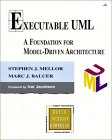 |
|---|
| Overview |
| Contents |
| FAQ |
| Authors |
| Register Your Copy |
| Discuss the Book on Yahoo Groups |
| Get the Models |
| Book Bugs |
Overview
Executable UML is a major innovation in the field of software development. It is designed to produce a comprehensive and understandable model of a solution independent of the organization of the software implementation. It is a highly abstract thinking tool that aids in the formalization of knowledge, and is also a way of describing the concepts that make up abstract solutions to software development problems.
This timely new book, Executable UML: A Foundation for Model-Driven
Architecture, thoroughly introduces, documents, and explains this
important new technology. The authors show how UML can formalize requirements
and use cases into a rich set of verifiable diagrams, how it can be used
to produce executable and testable models, and how these models can be translated
directly into code. In addition, the book explains how individual system
domains are woven together by an executable UML model compiler.
The book is full of tips and techniques to help you:
- Partition a system into subject matters based on individual aspects
- Pick the right level for use case modeling to speed subject matter comprehension
- Model classes and focus on relationships to capture subject matter semantics precisely
- Express behavior using the newly adopted UML action semantics and action languages
- Specify constraints using tags specified in OCL (Object Constraint Language)
- Synchronize objects by building lifecycles using statechart diagrams
- Model relationships and contention safely
- Distribute dynamics to avoid unmaintainable controller objects
- Verify the models by executing test cases against the statechart diagrams and constraints